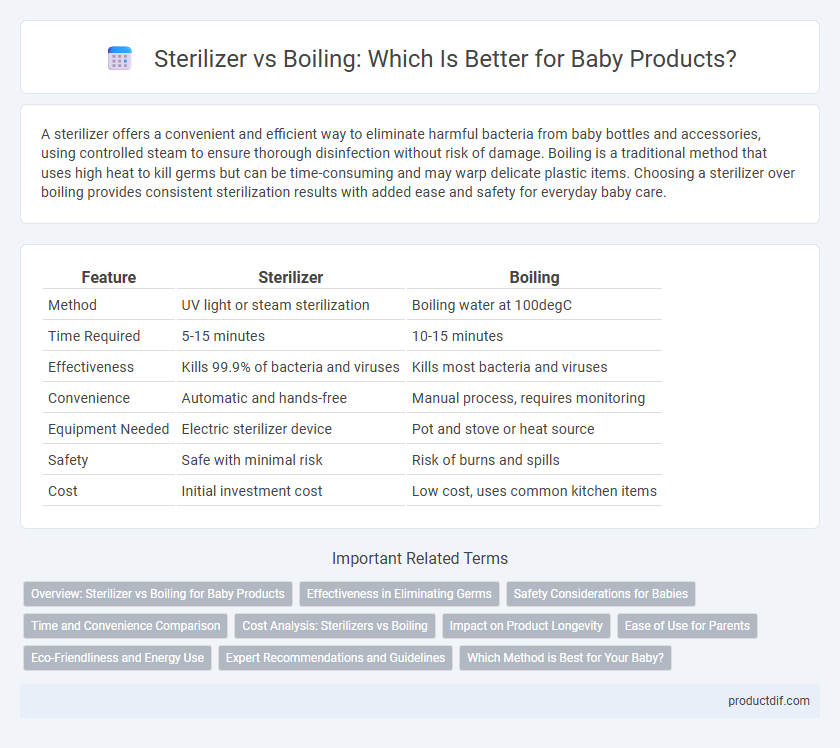A sterilizer offers a convenient and efficient way to eliminate harmful bacteria from baby bottles and accessories, using controlled steam to ensure thorough disinfection without risk of damage. Boiling is a traditional method that uses high heat to kill germs but can be time-consuming and may warp delicate plastic items. Choosing a sterilizer over boiling provides consistent sterilization results with added ease and safety for everyday baby care.
Table of Comparison
| Feature | Sterilizer | Boiling |
|---|---|---|
| Method | UV light or steam sterilization | Boiling water at 100degC |
| Time Required | 5-15 minutes | 10-15 minutes |
| Effectiveness | Kills 99.9% of bacteria and viruses | Kills most bacteria and viruses |
| Convenience | Automatic and hands-free | Manual process, requires monitoring |
| Equipment Needed | Electric sterilizer device | Pot and stove or heat source |
| Safety | Safe with minimal risk | Risk of burns and spills |
| Cost | Initial investment cost | Low cost, uses common kitchen items |
Overview: Sterilizer vs Boiling for Baby Products
Sterilizers offer precise temperature control and shorter cycle times, ensuring effective elimination of bacteria and viruses from baby bottles and accessories. Boiling, a traditional method, requires submerging items in boiling water for at least five minutes but may cause faster wear on plastic components and lacks temperature regulation. Choosing between a sterilizer and boiling depends on convenience, material safety, and thoroughness of sterilization for baby products.
Effectiveness in Eliminating Germs
Sterilizers utilize advanced UV light or steam technology to eliminate up to 99.9% of bacteria, viruses, and harmful germs from baby bottles and accessories, providing a more consistent and reliable sterilization process. Boiling water effectively kills most common pathogens but may not reach all microorganisms or ensure uniform sterilization, especially in hard-to-reach areas. Studies indicate sterilizers offer a higher degree of germ elimination, making them a preferred choice for maintaining baby product hygiene.
Safety Considerations for Babies
Sterilizers offer a controlled and consistent method to eliminate harmful bacteria and viruses from baby bottles and accessories, ensuring a higher level of safety compared to boiling. Boiling water may not evenly sterilize items and poses risks of burns or accidents during handling, making it less secure for busy parents. Using electric or microwave steam sterilizers minimizes contamination risks, safeguarding infants' health more effectively.
Time and Convenience Comparison
Sterilizers offer a faster and more convenient method for disinfecting baby bottles, typically completing the process in 5 to 15 minutes, compared to boiling which requires at least 10 minutes plus additional time to heat and cool. Electric sterilizers are designed with automated cycles and can hold multiple bottles, reducing manual effort and ensuring consistent sterilization. Boiling demands constant supervision and can be less practical for busy parents looking for a reliable and time-saving solution.
Cost Analysis: Sterilizers vs Boiling
Electric baby sterilizers typically range from $30 to $100, offering convenience and consistent sterilization times, while boiling water methods incur minimal direct costs but demand energy expenses and significant time investment. Sterilizers provide efficient sterilization in 5 to 15 minutes per cycle, reducing labor and water usage compared to boiling, which requires sustained heating for at least 10 minutes per sterilization session. Long-term cost analysis reveals that although sterilizers have higher upfront costs, they reduce utility bills and time costs, making them cost-effective for frequent use compared to the energy consumption and manual effort involved in boiling.
Impact on Product Longevity
Sterilizers use controlled heat and steam to effectively eliminate bacteria while preserving the integrity of baby bottles and accessories, extending their lifespan. Boiling exposes items to intense heat and water, which can cause faster wear and warping, reducing product durability. Choosing sterilization methods designed for baby products helps maintain material quality and ensures longer-lasting safety.
Ease of Use for Parents
Sterilizers offer a more convenient and time-saving solution compared to traditional boiling, requiring minimal effort from parents with simple one-touch operations. Unlike boiling, which demands constant supervision and precise timing to ensure effective sterilization, sterilizers automate the process, reducing the risk of errors. This ease of use makes sterilizers highly suitable for busy parents seeking efficient and reliable baby product sanitation.
Eco-Friendliness and Energy Use
Sterilizers designed for baby products offer greater eco-friendliness by using less water and energy compared to traditional boiling methods that consume high amounts of fuel or electricity for prolonged periods. Modern electric sterilizers often include energy-efficient settings and reduce plastic waste by extending the lifespan of baby bottles and accessories. Boiling, while effective, can lead to higher carbon emissions due to repeated heating cycles and excessive water usage.
Expert Recommendations and Guidelines
Experts recommend using electric steam sterilizers for baby bottles due to their efficiency and ability to eliminate 99.9% of harmful bacteria without damaging delicate materials. Boiling remains a traditional method endorsed by pediatricians for its simplicity and effectiveness, though it may degrade plastic components over time. Health guidelines emphasize sterilizers as a safer, time-saving alternative, especially for frequent sterilization in high-risk environments.
Which Method is Best for Your Baby?
Choosing the best method for baby bottle sanitation depends on safety, effectiveness, and convenience. Sterilizers use steam technology to eliminate 99.9% of harmful bacteria without chemicals, preserving bottle longevity and saving time compared to boiling, which requires water heating for at least five minutes and risks plastic deformation. For parents seeking a reliable, quick, and gentle sterilization process, electric or microwave sterilizers offer superior protection for their baby's health and hygiene.
Sterilizer vs Boiling Infographic

 productdif.com
productdif.com